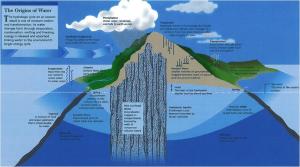When I first moved to Hawaii as a new hydrologist for the U.S. Geological Survey, one of my first questions was: “Here on a volcanic island surrounded by sea water with no surface reservoirs for storage, where do the islanders get their fresh drinking water?” Because the material making up the islands is very permeable, everything below sea level must be already saturated with sea water.
The geology reports all showed that over 90% of Hawaii’s water supply is from groundwater but its origin still puzzled me. Then I was informed about the density differences between the abundant rainwater and native intruded sea water below the islands. Infiltrated rainwater has a total mineral content of about 50-100 ppm (parts per million) or mg/L (milligrams per Liter) and the sea water up to sea level beneath the islands has a total dissolves solids concentration of over 35,000 ppm or mg/L. This significant difference in mineral content also results in a very significant difference in density of the fresh rainwater and basal groundwater which is essentially sea water below the islands. This condition called the Ghyben Herzberg principal is the reason why the fresh water actually floats on the salt water. Additionally, the weight of the freshwater bubble on top of the sea water depressed the interface at a ratio of 40:1. Meaning that for each one foot of freshwater measured above sea level, there are 40 feet of freshwater depressing the sometimes interface between the fresh water above and the sea water below.
In some areas of the islands there are vertical dikes of almost impermeable rocks that have intruded into the permeable volcanic rock. These vertical dikes have created protected cells for the fresh rainwater to be stored within the ground well above the salt water level. The erosion of the rock making up the exposed volcano above the sea level has resulted in a layer of caprock deposits along the shore line. The very low permeability of this caprock actually restricts the flow of freshwater outward to the ocean.

